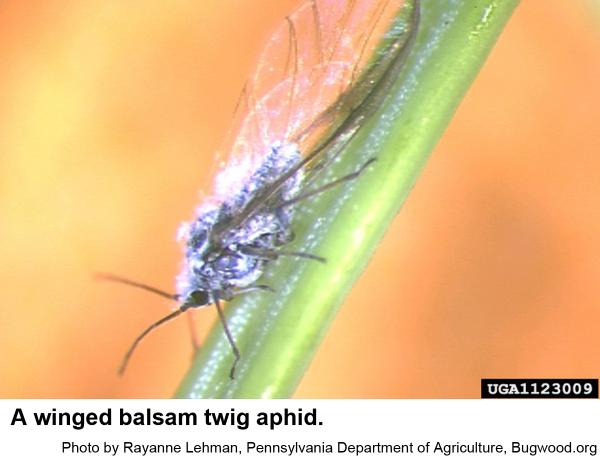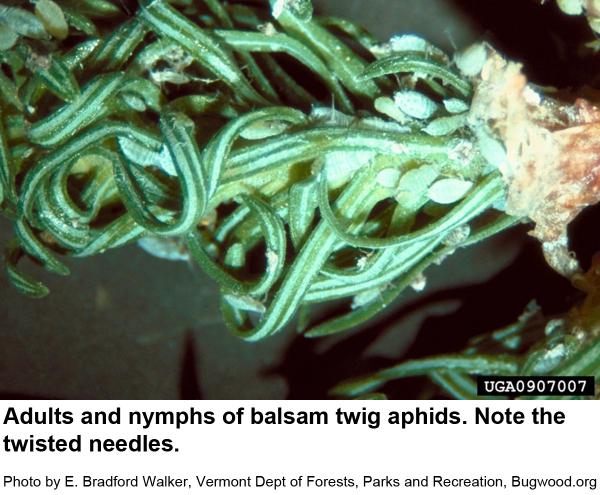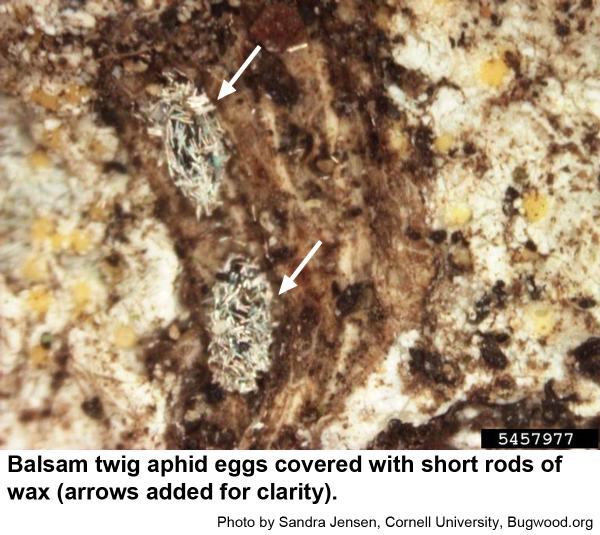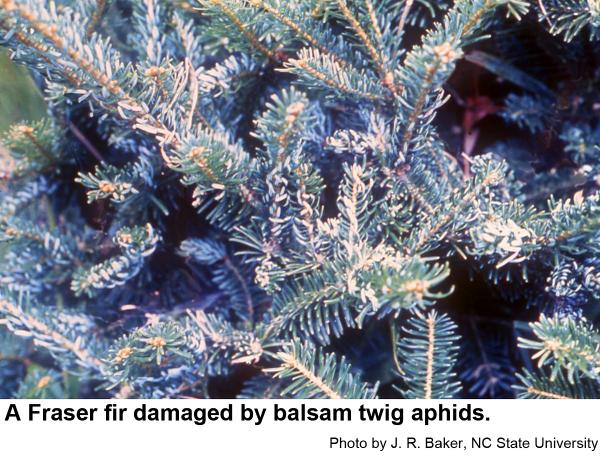Description and Biology
The balsam twig aphid, Mindarus abietinus, has a complex life history with three distinct forms occurring during a single generation. Winged balsam twig aphids are 1/16 to almost 1/8 inch long. In the spring overwintering eggs hatch. After three molts, nymphs develop into wingless adults called stem mothers that give birth to living young. The stem mothers are plump, covered with a snowy powder and often obscurred by waxy filaments protruding from their abdomens. Whereas many aphids have conspicuous cornicles, those of the balsam twig aphid are much reduced. Offspring gather in a colony around the greenish or blue-gray parent and feed on old needles and buds. Offspring also produce a white waxy covering over ther bodies. Nymphs are very small, pale yellowish-green and wingless. Plump nymphs develop into wingless females (called fundatrices) that give birth to more nymphs. From mid June to mid July, slender nymphs are born that develop into winged female and male adults called sexuales. These winged aphids mate, lay eggs, and disappear. The rest of the year is spent as eggs in crevices of the bark or sometimes on needles. Eggs are black and covered with small, white rods of wax.
Host Plants
This insect has been reported on alpine fir, balsam fir, Fraser fir, grand fir, Siberian fir, and white fir. When populations are high on firs, some aphids fall onto other conifers and can complete their development on white spruce and juniper. Balsam twig aphids excrete copious amounts of honeydew in which can develop black sooty mold fungi. Aphid feeding may also cause twists and curls in the needles as well as roughened bark. Heavy infestations can reduce the value of Christmas trees and even cause stunt small trees.
Residential Recommendations
Control of balsam twig aphids is difficult because damage occurs in early spring when weather is unpredictable. Insecticidal soaps and other insecticides labeled for landscape use should be effective in preventing noticeable damage if applied early enough. As the weather warms up, lady beetles, syrphid maggots, aphid lions and other predators help limit balsam twig aphid populations.
Other Resources
- Aphids on Ornamental Landscape Plants. Frank, S. 2009. Entomology Insect Notes, NC State Extension Publications.
- Mindarus abietinus, Balsam twig aphid. Brightwell, R. et al. 2018. InfluentialPoints.com.
- Sooty Molds. Frank, S. et al. 2002. Entomology Insect Notes, NC State Extension Publications.
- Insect and Related Pests of Shrubs. Baker, J. R. ed. 1980. NC Agr. Extension Service pub. AG-189. 199 pp.
- Extension Plant Pathology Publications and Factsheets
- Horticultural Science Publications
- North Carolina Agricultural Chemicals Manual
For assistance with a specific problem, contact your local Cooperative Extension Center
This publication has not been peer reviewed.
Publication date: March 13, 2019
Reviewed/Revised: Dec. 20, 2023
Recommendations for the use of agricultural chemicals are included in this publication as a convenience to the reader. The use of brand names and any mention or listing of commercial products or services in this publication does not imply endorsement by NC State University or N.C. A&T State University nor discrimination against similar products or services not mentioned. Individuals who use agricultural chemicals are responsible for ensuring that the intended use complies with current regulations and conforms to the product label. Be sure to obtain current information about usage regulations and examine a current product label before applying any chemical. For assistance, contact your local N.C. Cooperative Extension county center.
N.C. Cooperative Extension prohibits discrimination and harassment regardless of age, color, disability, family and marital status, gender identity, national origin, political beliefs, race, religion, sex (including pregnancy), sexual orientation and veteran status.





